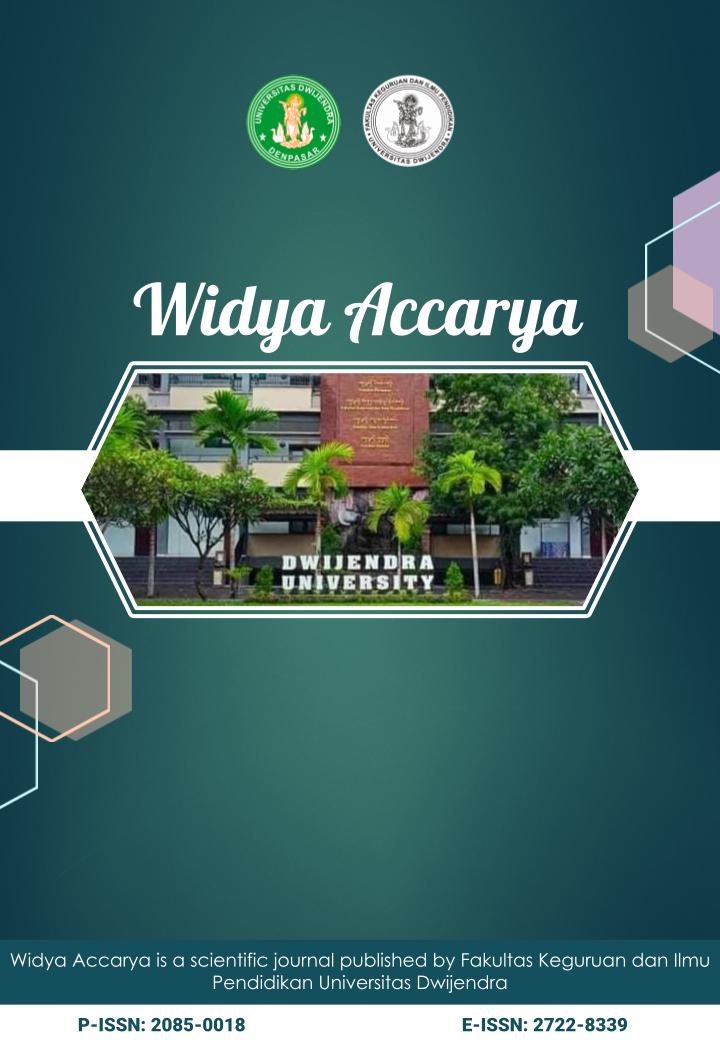Measuring The Quality of Learning Services in Relation to Students’ Loyalty Towards Learning Quality The Teacher Profession Education Program
DOI:
https://doi.org/10.46650/wa.16.2.1667.100-107Keywords:
learning quality, loyalty, services, mediation, PPGAbstract
References
Abili, K., Narenji Thani, F. and Afarinandehbin, M. (2012) ‘Measuring university service quality by means of Servqual method’, Asian Journal on Quality, 13(3), pp. 204–211. doi: 10.1108/15982681211287766.
Alemu, A. (2023) ‘Assesing Service Quality in Tertiary Education Using Adapted Servqual Scale’, Cogent Education, 10(2), pp. 1–15. doi: 10.1080/2331186X.2023.2259733.
Amalia, N. L., Suprihanto, S. and Hamid, E. (2022) ‘Analisis Return on Equity dan Return on Assets dalam Menilai Pertumbuhan Laba pada PT. Indofood Sukses Makmur Tbk Periode Tahun 2016 – 2020’, Parameter, 7(2), pp. 224–238.
Anshori, A. et al. (2022) ‘Dynamic and New Paradigm of Islamic Education in Indonesia’, Scaffolding: jurnal pendidikan Islam dan Multikulturalisme, 4(2), pp. 232–245. doi: https://doi.org/10.37680/scaffolding.v4i2.1573.
Argaheni, N. B. (2020) ‘Sistematik review: dampak perkuliahan daring saat pandemi Covid-19 terhadap mahasiswa Indonesia’, Placentum Jurnal Kesehatan dan Aplikasinya, 2, pp. 99–108.
Calvo-Porral, C., Levy-Mangin, J. P. and Novo-Corti, I. (2013) ‘Perceived quality in higher education: An empirical studi’, Marketing Intelligence and Planning, 31(6), pp. 601–619. doi: http://dx.doi.org/10.1108/MIP-11-2012-0136.
Delgado-Ballester, E. and Munuera-Aleman, J. (2003) ‘Brand Trust in the Context of Consumer Loyalty.’, European Journal of Marketing, 35, pp. 1238–1258. doi: 10.1108/EUM0000000006475.
Ferdinand, A. (2014) Structural Equation Modeling in Management Research. 5th edn. Semarang: BP Undip -Undip Press.
Hair, J. F. et al. (2020) Multivariate Data Analysis. 7th edn. New Jersey: Prentice Hall International Inc.
Hennig-Thurau, T., Langer, M. F. and Hansen, U. (2001) ‘Modeling and Managing Student Loyalty :an Approach Based on the Concept of Relationship Quality’, Journal of Services Research, 3(4), pp. 331–344. doi: 10.1177/109467050134006.
Ismael, F. and Iswantir (2022) ‘Konsep Pendidikan Sekolah Islam Terpadu’, Jurnal Penelitian Ilmu Pendidikan Indonesia., 1(2), pp. 127–134. doi: 10.31004/jpion.v1i2.30.
Kanakana, M. G. (2014) ‘Assesing service quality in higher education using the servqual Tool’, International Confrence on Industrial Engineering and Operations Management, 1(969), pp. 68–74.
Kemendikbud (2019) ‘PJJ, E-Learning& Blended Learning’. Direktorat Pembelajaran dan Kemahasiswaan Dirjen Dikti Kemendikbud RI.
Li, S. C. (2013) ‘Exploring the Relationships among Service Quality, Customer Loyalty and Word-of-Mouth for Private Higher Education in Taiwan’, Asia Pacific Management Review, 18(4), pp. 375-389. doi: 10.4236/jss.2020.84002.
Martono, S. (2021) ‘Evaluasi Mutu layanan Pendidikan Tinggi (Studi Program Studi Akuntansi Fakultas Ekonomika Bisnis Universitas Kristen Satya wacana’, JEMAP: Jurnal Ekonomi Manajemen Akuntansi dan perpajakan, 4(2), pp. 28–51.
Novinfar, A. E. et al. (2011) ‘Evaluation of the Quality of Education Services of Payam Noor University of Hoedan based on Servqual Model’, Journal of Research and Planning in Higher educatioan, 17(3), pp. 135–152.
Parasuraman, A., Berry, L. L. and Zeithaml, V. A. (1998) ‘A Conceptual Model of Service Quality and Its implication.’, Journal of Marketing, 49(fall), pp. 41–50.
Pranoto, I. (2020) ‘Kurikulum Berbasis Nalar, Opini’, Kompas, 20 October.
Rangkuti, F. (2013) Customer Service Satisfaction & Call Center Berdasarkan ISO 9001. Jakarta: Gramedia.
Rezaei, S. et al. (2017) ‘Evaluating service quality in the higher education sector in Iran: an examination of students’ perspective’, International Journal of Human Rights in Healthcare, 10(2), pp. 146–155. doi: 10.1108/IJHRH-12-2016-0024.
Saputra, R. A. and Fernandes, R. (2023) ‘Strategi Sekolah Mengantisipasi Learning Loss Pasca Pandemi Covid 19 ( Studi Kasus: Siswa Kelas XII di SMA Negeri 2 Gunung Talang)’, Naradidik: Journal of Education & Pedagogy, 2(1), pp. 77–86. doi: 10.24036/nara.v2i1.95.
Setiawan, R., Mardapi, D. and Pratama, A. (2019) ‘Efektivitas blended learning dalam Inovasi pendidikan era Industri 4.0 pada mata kuliah Teori tes Klasik’, Jurnal Inovasi Teknologi Pendidikan, 6(2), pp. 148–157. doi: http://dx.doi.org/10.21831/jitp.v6i2.27259.
Singarimbun, M. . and Effendi, S. (1985) Metode Penelitian Survey. Jakarta: LP3ES.
Sweis, R. J. et al. (2016) ‘Assessing service quality in secondary schools: the case of Jordan’, Benchmarking: An International Journal, 23(5), pp. 1207–1226. doi: 10.1108/BIJ-04-2015-0031.
Teristonia, N. L. P., Widiana, I. W. and Bayu, G. W. (2022) ‘Fenomena Learning Loss pada Siswa Sekolah Dasar Pasca Pandemi Covid-19’, Jurnal Ilmiah Pendidikan dan Pembelajaran, 6(3), pp. 477–487. doi: 10.23887/jipp.v6i3.57469.
Yuhanis, A. and Nyen, C. (2012) ‘The Role of Halal Awareness and Halal Sertification in Influencing non-Muslims Purchase Intention’, in 3rd International Conference on Business and economic Research Proceeding.
Downloads
Published
How to Cite
Issue
Section
Citation Check
License
Copyright (c) 2025 Arif Julianto Sri Nugroho, Hersulastuti, Purwo Haryono, Tasari, Tukiyo, DB Putut Setiyadi

This work is licensed under a Creative Commons Attribution-ShareAlike 4.0 International License.
An author who publishes in the Widya Accarya agrees to the following terms:
- Author retains the copyright and grants the journal the right of first publication of the work simultaneously licensed under the Creative Commons Attribution-ShareAlike 4.0 License that allows others to share the work with an acknowledgement of the work's authorship and initial publication in this journal
- Author is able to enter into separate, additional contractual arrangements for the non-exclusive distribution of the journal's published version of the work (e.g., post it to an institutional repository or publish it in a book) with the acknowledgement of its initial publication in this journal.
- Author is permitted and encouraged to post his/her work online (e.g., in institutional repositories or on their website) prior to and during the submission process, as it can lead to productive exchanges, as well as earlier and greater citation of the published work (See The Effect of Open Access).
Read more about the Creative Commons Attribution-ShareAlike 4.0 Licence here: https://creativecommons.org/licenses/by-sa/4.0/.

















